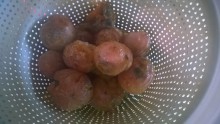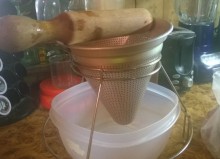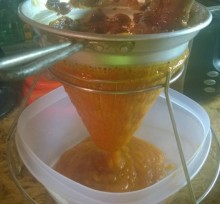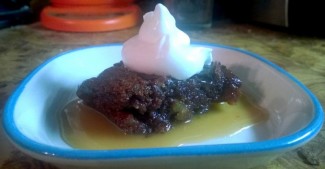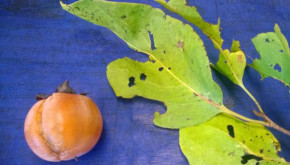
Hunting for persimmons on our little 30-acre wood is something that I look forward to all year. I start in the spring checking to see if our native persimmon trees (Diospyros virginiana) have blossoms. During the summer, I check to see if the trees have set fruit. Towards the end of summer, I hope against hope that drought or excessive wind, or an especially hungry raccoon, hasn’t stripped my trees of fruit. And finally, in the fall, if I’m lucky and time it just right, I can gather the wonderfully sweet persimmons to use in ice cream, breads, cookies, puddings, and cakes. All of this sounds very straightforward but there are several tricks to know about with persimmons.
First of all, there are male and female trees. How do you tell the difference, you may ask. Females have fruit. Males don’t. Actually, both the male and the female trees have flowers. The female flowers are solitary, bell-shaped, yellow, and about ½ inch wide. The male flowers are smaller and are closely grouped. So look for a tree with single flowers.
The second trick is to know when the fruit is ripe. Common wisdom tells us to harvest the persimmon after the first frost. That’s not entirely correct. The fruit is ripe when it is fairly soft. It often will have a whitish bloom. The cap can also be removed easily when it’s ripe. We harvest the fruit when it has fallen and is soft: if we can beat the animals to the fruit. The best test if the fruit is soft is to simply pop it into your mouth. If it’s bitter, spit it out. What you do NOT want to ever do is eat a hard, green persimmon. You’ll pucker up as if you’ve taken a teaspoon of Alum. Or as friend said yesterday, it feels like your mouth is turned inside out. So, if it’s soft and squishy, it’s ready to eat.
The third trick to using native persimmons is seeding pulping the fruit. There is no easy way to remove the seeds from the fruit. I use an old jelly making colander and the wooden mallet to pulp the fruit. I’ve tried a food mill: it didn’t work. The bitterness found in persimmons comes from the seed and the membrane holding the seed together. A food mill grinds up part of the seed and therefore transfers the bitterness to the pulp. Using the mallet and colander or jelly strainer, does a pretty good job. The end product is a beautiful deep orange pulp. It’s sweet and rich tasting.
However, there is one more step needed if you plan to bake or otherwise cook the pulp. I had to learn this the hard way. The first time (and only time) I baked a persimmon custard pie -- for Thanksgiving by the way -- it was inedible. It was bitter and no amount of whipped cream could save it. We literally ate the cream and threw the pie out. Thank goodness we didn’t have company for Thanksgiving! I learned the secret trick a couple of years later, and here it is: add 1 teaspoon of baking soda to ¾ cup of raw persimmon pulp. Let this sit for 30 minutes and a remarkable transformation happens! The pulp assumes a texture rather like a firm custard or gelatin and it does not turn bitter when baked or cooked. You can then use it in cookies, cakes, breads, pies, cinnamon rolls, or puddings. The pulp will lose its beautiful color when cooked and will turn a dark brown. If you plan on using the raw pulp in ice cream then the baking soda treatment is not required.
There are hundreds of persimmon recipes! Persimmon cinnamon rolls and persimmon ice cream are two of my favorites. I tried a persimmon pudding this weekend. I was somewhat apprehensive. The recipe is basically the same one used in custard pie recipes. I envisioned another dismal failure in which we would eat the cream and throw the pudding out to the animals, but the pudding was fine. I made a sea salt caramel whiskey sauce and whipped cream to go with the pudding. It was moist, somewhat dense, and as my husband said, “tasted like persimmons.” I’m not sure that he meant it as high praise but he did eat it!
We have such an abundance of persimmons this year that I will probably be test driving several new recipes and maybe finally make that persimmon custard pie again! So get out there and try our native persimmon! It is indeed “divine fruit”.


